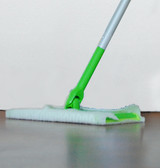How to Clean and Care For your Bamboo Floor

Bamboo flooring is durable, but not invincible, and can be easy to maintain, though the frequency with which your floor will need maintenance will depend on your room traffic.
Cleaning
For daily cleaning, you can use a soft, dry type mop, in the style of a Swiffer or a standard dust mop. You can also use a vacuum cleaner, as long as it does not have a beater bar, or has special attachments specifically designed for hardwood cleaning. The beater bar can actually leave dents in a bamboo floor, you see. Any of these will keep dust and dirt from building up.
Concentrated areas of dirt, or even sticky material just use a damp cloth or a slightly damp mop. Don’t use either “wet” please. Be sure to really wring it out, because we don’t want to generate even small amounts of standing water. In fact, any spilled liquids should be blotted or wiped up immediately, and then the floor should be allowed to dry completely.
Never use on your bamboo floor:
Steel wool, or anything like it, meaning any kind of abrasive pads generally used for scouring.
Scouring detergent chemicals. Scour is a Bamboo Bad word. No or abrasives like Soft Scrub either.
Corrosive cleaning chemicals (Lime Away is a good example)
Also,
Oil based cleaning agents
General household cleaning chemicals
and floor wax
… are unable to get through the surface of bamboo flooring. This means that the chemicals will build up, and the finish may become damaged, to say nothing of dull, covered with an unpleasant, possibly slippery film. The resultant effects can require deep sanding to fix if this happens frequently enough or is left unattended to for long.
General Care
To avoid scratching and denting, use felt or soft rubber rollers or glides on the bases of any furniture that will be moving. If you’re using glides, sweep first, and check that they don’t accumulate dirt as you move. This grit can turn into little, tiny blades on your flooring.
Even though you will have acclimated your bamboo to the room before installing it, there will still be an optimal humidity range within which the floor must reside. You should check the documentation that comes with your floor, especially the warranty, for exact levels. Generally the ranges run close to 30-60% relative humidity. If it gets above that, the flooring may absorb some of the air’s excess moisture and swell, perhaps even cup, which is when boards bend into a slight arc as they press against each other. A quick way to keep this in check is to run an air conditioner, which will directly dry out the air, or to run the heat. The latter raises not only the temperature, but also the moisture capacity of the air, therefore lowering the relative humidity.
If the air gets too dry, the flooring may release some of its own moisture and then shrink, allowing gaps to form between the planks. In this case, you would need a humidifier. It’s best to keep a generally stable level of relative humidity in the range allowed by the manufacturer. These days, humidity monitors can be found almost as cheaply as room thermometers, and might be useful to have in the room if you live in an area where humidity greatly fluctuates.
For areas likely to have heavy traffic or frequent contact with dirt, such as doorways, floor mats are recommended. If you go for carpet style mats, make sure they don’t have scratchy under-surfaces, and are colorfast. Planters should have drip pans under them. In the kitchen, bathrooms, laundry areas and especially under pets’ water bowls, waterproof mats are highly recommended.
While bamboo is not as prone to fading or changing of color as most real hardwood flooring, it is still not recommended to have areas of the floor regularly exposed to a lot of direct sunlight. For this reason, it’s good to regularly move any area rugs into different spots.
Never, never, never walk on a bamboo floor in high heeled shoes. Likewise, well treaded shoes should be checked upon entrance to a house for embedded gravel or hard dirt that can turn into a version of the same thing, and scratch or dent the flooring.
– – – –
David has written and made videos about flooring products and installation since 2011 at Floors To Your Home (.com), where he is also the PPC Manager, a Researcher, a Website & Marketing Strategy Team member, Videographer, Social Strategist, Photographer and all around Resource Jito. In my spare time I shoot and edit video, put together a podcast, explore film history, and mix music (as in ‘play with Beatles multi-tracks’). Connect with W. David Lichty
Follow Team Floors To Your Home on Facebook

 Brown Tone
Brown Tone
 Unfinished
Unfinished
 Red Tone
Red Tone
 Golden Tone
Golden Tone
 Gray Tone
Gray Tone
 Light Tone
Light Tone
 Medium Tone
Medium Tone
 Dark Tone
Dark Tone
 Brown Tone
Brown Tone
 Red Tone
Red Tone
 Golden Tone
Golden Tone
 Gray Tone
Gray Tone
 Light Tone
Light Tone
 Medium Tone
Medium Tone
 Dark Tone
Dark Tone
 Brown Tone
Brown Tone
 Red Tone
Red Tone
 Golden Tone
Golden Tone
 Gray Tone
Gray Tone
 Light Tone
Light Tone
 Medium Tone
Medium Tone
 Dark Tone
Dark Tone
 Multi Color
Multi Color

